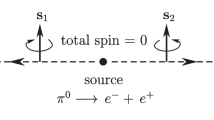Summary
We start from the new idea that isotopic spin space is invariant under the group of three dimensional complex conjugate rotations and justify this assumption on the basis of a classical model of extended particles described by relativistic rotators. We then express in terms of Euler parameters (a relativistic generalization of real three dimensional Euler angles) the infinitesimal operators of the Lie algebra associated with this group and obtain, in the general space of the corresponding eigenfunctions, finite dimensional sub-spaces associated with irreducible representations of the complex rotation group. In each subspace one then readily defines a set of « isotopic » or « internal state vectors » corresponding to different types of elementary particles so that each particle family is connected with an irreducible representation of this group. In this scheme isotopic strangeness and fermionic numbers correspond to certain infinitesimal rotation operators and one justifies (with new qualitative aspects) the empirical Nishijima-Gell-Mann classification of elementary particles.
Riassunto
Partiamo dalla nuova idea che lo spazio dello spin isotopico è invariante rispetto al gruppo delle rotazioni coniugate complesse tridimensionali e giustifichiamo questa ipotesi sulla base di un modello classico di particelle estese descritte da rotatori relativistici. Poi esprimiamo in termini dei parametri di Eulero (generalizzazione relativistica degli angoli reali tridimensionali di Eulero) gli operatori infinitesimali dell’algebra di Lie associati a questo gruppo ed otteniamo, nello spazio generale delle autofunzioni corrispondenti, sottospazi dimensionali finiti associati a rappresentazioni irriducibili del gruppo completo di rotazione complessa. In ogni sottospazio si definisce facilmente una serie di « vettori di stato isotopici o interni » corrispondenti a differenti specie di particelle elementari in modo che ogni famiglia di particelle sia connessa ad una rappresentazione irriducibile di questo gruppo. In questo schema i numeri di stranezza isotopica e fermionici corrispondono a certi operatori infinitesimali di rotazione e si giustifica (con nuovi aspetti qualitativi) la classificazione empirica di Nishijima-Gell-Mann delle particelle elementari.
Similar content being viewed by others
References
See the paper byd’Espagnat andPrentki inProgress in Elementary Particle and Cosmic Ray Physics, vol.4 (Amsterdam, 1958).
D. Bohm, P. Hillion, T. Takabayasi andJ.-P. Vigier:Relativistic rotator and bilocal theory, Progr. Theor. Phys.,23, 496 (1960).
D. Bohm, P. Hillion andJ.-P. Vigier:Internal quantum states of the hyperspherical relativistic rotator, to be published inProgr. Theor. Phys.
F. Halbwachs, P. Hillion andJ.-P. Vigier:Ann. Inst. Poincaré,16, 115 (1959).
C. Van Winter:Thésis (Groningen, 1957).
A. Einstein andW. Mayer:Sitz. Ber., 522 (Berlin, 1932).
P. Hillion andJ.-P. Vigier:Ann. Inst. Poincaré,16, 161 (1959).
P. Hillion andJ.-P. Vigier:Ann. Inst. Poincaré,16, 217 (1959).
E. Cartan:Leçon sur la théorie des spineurs (Paris).
See for instanceE. M. Corson:Introduction to tensors, spinors and relativistic wave equations (New York).
See for instanceH. Umezawa:Quantum Field Theory (Amsterdam).
J. C. Polkinghorne andA. Salam:Nuovo Cimento,15, 160 (1960).
D. Bohm andJ.-P. Vigier:Phys. Rev.,96, 208 (1956).
L. De Broglie, P. Hillion andJ.-P. Vigier:Compt. Rend.,249, 2255 (1959).
Author information
Authors and Affiliations
Additional information
This work is in fact part of a common program of research established in Bristol with ProfessorBohm and inserts itself very naturally in the frame of the causal interpretation of Quantum Mechanics.
Rights and permissions
About this article
Cite this article
Hillion, P., Vigier, J.P. New isotopic spin space and classification of elementary particles. Nuovo Cim 18, 209–228 (1960). https://doi.org/10.1007/BF02725934
Received:
Published:
Issue Date:
DOI: https://doi.org/10.1007/BF02725934




